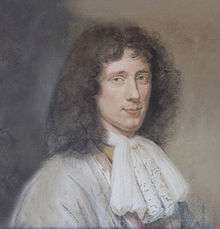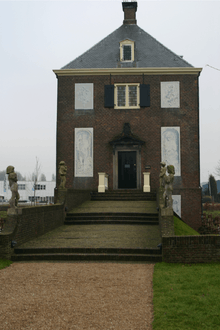Hofwijck

Hofwijck (Dutch pronunciation: [ˈɦɔfʋɛik]; or Vitaulium in Latin) is a mansion built for 17th-century politician Constantijn Huygens. It is located in Voorburg on the Vliet canal from Den Haag to Leiden, and its formal address is 2 Westeinde, Voorburg, the Netherlands,[1][2] but its location today is better known as the Voorburg railway station.
Construction
After he became a widower, Huygens bought land on the Vliet in Voorburg with plans to build a summer home while the Vliet itself was still being dug in 1638. At the time it was quite fashionable to have a summer home on a river or canal, and old maps of Voorburg show Hofwijck as one of many. The building itself and the gardens (originally on both sides of the Vliet) were designed by Huygens himself in cooperation with the architect Jacob van Campen.[1] The estate was to be "a harmonious piece of paradise on earth, with a garden in God’s image and likeness." Huygens was very much inspired by the works of classical Roman architect Vitruvius.[2] Pieter Post was in charge of the actual building activities.[1]
The building was erected in unplastered brick and is in the Classicist style. It stands in the centre of a square swan pond.[1] Hofwijck was inaugurated in 1642 in the company of friends and relatives.[2]
Collection
In the collection on display are various items from the Dutch Royal family that have to do with the work of either Constantijn or his son Christiaan. In the display room for Christiaan, various types of clockworks are shown, as well as some original clocks. Family paintings and furniture are on display throughout the building, and the library of Huygens (now a small office) contains many of his books, and offers the same strategic view out of the window at any boat that may appear (today one only sees highway traffic at eye level, and barge traffic at water level).
-
Hofwijck from the station.
-
Christiaan Huygens room, with pendulum from the church in Scheveningen.
-

Hofwijck kitchen hearth.
-
Swan pie - Huygens kept swans by Royal permission.
-
Poem about Hofwijck on display.
-

Pastel portrait of Christiaan in 1686 by Bernard Vaillant, which hangs above a pendant portrait of his sister Susanna.
-
.jpg)
Pendant portrait Amalia van Solms-Braunfels
After Constantijn's death
When Constantijn died, his son, the scientist Christiaan Huygens, came to live there.[2] In 1750 the last Huygens to live there sold it.[1][2] Grossly neglected in later years, it was auctioned for demolition in 1849, which was avoided when it was acquired by politician Guillaume Groen van Prinsterer.[2]
The "Hofwijck Association" acquired it circa 1913, when demolition loomed again.[1][2] It is now a museum, which opened its door for the first time on June 12, 1928.[2]
Trivia
- Huygens had Hofwijck built so he would have a place to escape the tensions that life as a politician brought with it, and its name reflects this: "hof" means "(royal) court" and "wijck" means "escape". However, it has more than one meaning, because "hof" can also mean "garden" and "wijck" can also mean "place". The Latin name has a double meaning too: Vitaulium means "garden of life" as well as "garden of Vitruvius".[2]
- From 1950 to 1970 this house was on the Dutch 25 guilder note.
- Until 2006, the Dutch intercity trains stopped in Voorburg. This was the condition requested of the Dutch railway board by the city of Voorburg, when they gave a large piece of the garden to the building of the rails in the 19th century.
-

Most visitors originally arrived by trekschuit, so this is the rear view of the house, and the door for deliveries was under the little bridge.
-

Voorburg railway station. On the right is the Hofwijck gatehouse.
-

Voorburg station from the ground, the pond is part of the original garden.
Poem about Hofwijck
De groote webb is af; en ’t Hof genoegh beschreven: Eens moet het Hofwijck zijn. wie kent den draed van ’t leven, Hoe kort hij is, hoe taeij? de snaer die heldste luijdt Scheidt d’eerste menighmael van leven en van Luijt, Verkracht en over-reckt, of met der tijd versleten. [...] 'k Wil Hofwijck, als het is, 'k wil Hofwijck, als 't zal wezen, de vreemdeling doen zien, de Hollander doen lezen.
See also
References
- 1 2 3 4 5 6 Stenvert, Ronald; Chris Kolman; Saskia van Ginkel-Meester; Elisabeth Stades-Vischer; Sabine Broekhoven (2004). Monumenten in Nederland – Zuid-Holland. Zwolle: Waanders. pp. 516–517. ISBN 90-400-9034-3.
- 1 2 3 4 5 6 7 8 9 Stöver, Jos; Vincent Collette; Rianne van Hilten; Robert van Lit; Carla Oldenburger-Ebbers; Heimerick Tromp (2000). Kastelen en buitenplaatsen in Zuid-Holland. Zutphen: Walburg Pers. pp. 238–243. ISBN 90-5730-078-8.
External links
- Official site of museum
- Hofwijck, poem on
- Hofwijck, a documentary
- Hofwijck, an explanation of the poem and the house (nl)
(See Talk:Hofwijck/Sources in case of unclarity.)
Coordinates: 52°03′54″N 4°21′43″E / 52.06500°N 4.36194°E
%2C_prins_van_Oranje_(Atelier_of_Gerard_van_Honthorst%2C_1650).jpg)